This ginataang hipon with kalabasa (shrimp and squash in coconut sauce) recipe is yet another Filipino comfort food perfect for a cold day. It is actually my favorite Filipino food. It's quite a staple dish in my life! I had to develop a simpler version while making substitutions as little as possible. One thing I am grateful for is that it is a simple recipe. The three main ingredients are shrimp, coconut milk (or cream), and fish sauce. These three things are enough to give me a comforting and nostalgic taste and feel.

Since it is a flexible dish, you can leave out many ingredients and simply end up with shrimp in coconut sauce - the more straightforward dish known as ginataang hipon. But this recipe has a bit more since I also like to add vegetables. The recipe does provide you with options and guidelines if you end up with a different vision for your ginataan. Remember that no two homemade Filipino dishes are exactly the same, and there is nothing wrong with that. The diversity of ingredients and cooking techniques are all parts of what makes the Filipino cooking culture interesting!
Along with other braised Filipino dishes like adobo and nilaga, this one is relatively easy to make once your ingredients are laid out. Go here for the full breakdown of the recipe with pictures.
What is Ginataang Hipon
To better understand this dish, you should know that ginataan is any braised dish in coconut milk or cream. Anything can be braised in coconut milk. Then the given name of the dish would be ginataang [insert food here]. So in Tagalog shrimp is hipon, therefore we use the name ginataang hipon. Kalabasa is squash, particularly pumpkin, so the recipe in this post is called ginataang hipon at kalabasa, meaning shrimp and squash in coconut sauce.
What is in Ginataang Hipon Kalabasa
Ginataang hipon isn't typically dressed with other vegetables. Most Filipinos would expect only shrimp braised in coconut milk (or cream) if you were to say you made ginataang hipon. But I like to add some pumpkin and other vegetables to add more color to this dish.
Type of Squash to Use
There are many types of squash out there. While it's totally fine to add whatever is available in the supermarket, kabocha is the best type of pumpkin to add to this dish. It's noticeably sweet and absorbs the flavors of the shrimp and fat from coconut milk. The slices also create a pretty orange color during the cooking period.
Where I live, only butternut squash is available during this time. Butternut doesn't leave a color when boiled like kabocha. It is also more structured, so it doesn't absorb flavors as much. I had to improvise the color by adding a bit of turmeric while supplementing the dish with butternut as kalabasa.
How to Make Ginataang Hipon Kalabasa
Devein Shrimp
Shrimp with the head on should be used for a more traditional look, but I could only find headless skin on shrimp. Before starting on this ginataang hipon recipe, devein the shrimp while keeping the skin on as much as possible.
Cook Aromatics
Heat some oil in a medium or a large-sized stockpot, then add the onions, garlic, and ginger. Cook the aromatics until the onions are glassy and the garlic and ginger are still slightly browned.
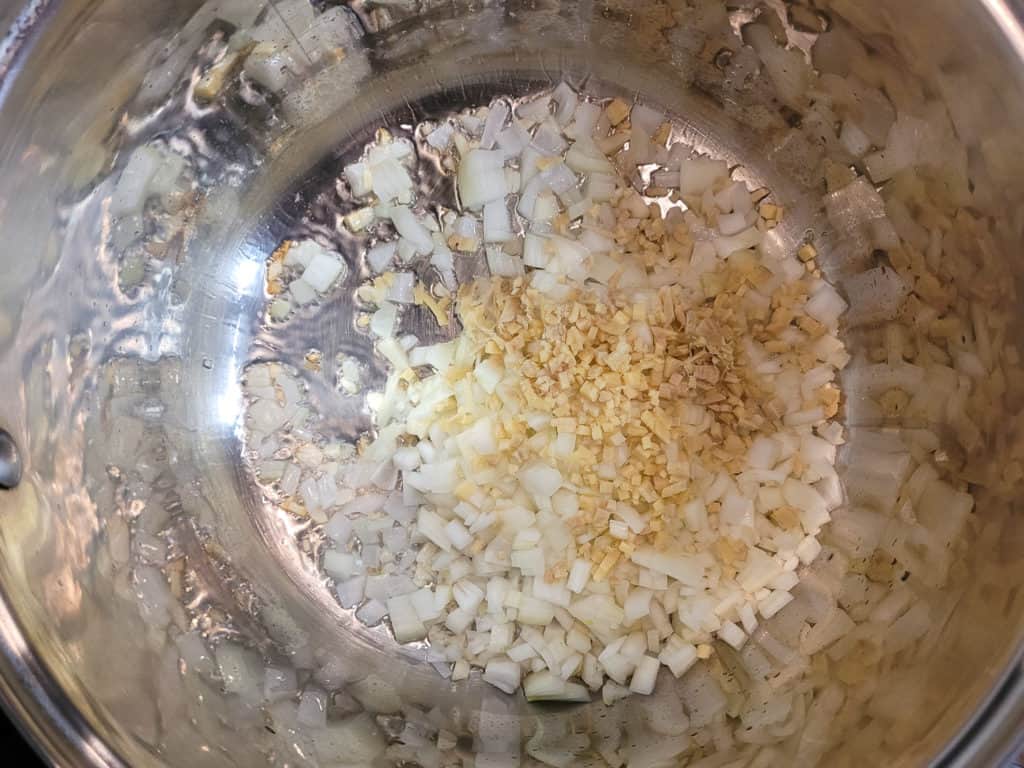
Add Coconut Milk
Open a can of coconut milk and pour it into the pot. Tip If you want a thicker coconut sauce and not so soupy, use coconut cream instead of coconut milk. Alternatively, you can add some water to thin out the soup - just make sure to salt it to your preference.
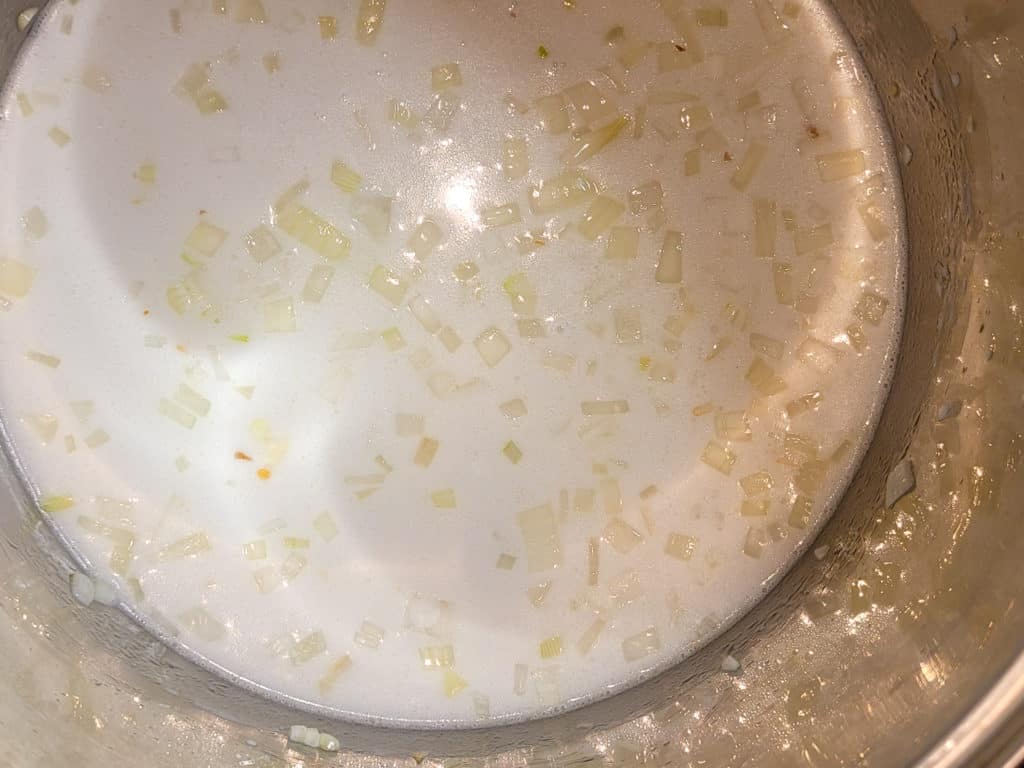
Add the sliced pumpkin and green beans to add more color. Mix everything before finally adding the fish sauce. Tip Where I live, there is no alamang (Filipino shrimp paste), a traditional ingredient. Although I opted out of this, feel free to add some to create more depth to the flavor!
Allow it to simmer on low heat for about ten to fifteen minutes. Tip Make sure the heat setting is set to low. High heat will harden the shrimp and make for a rubbery texture that we don't want!
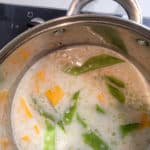
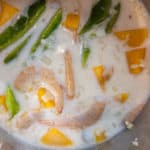
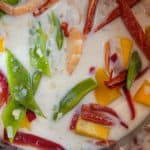
Next, add the shrimp and let it simmer for between five to eight minutes. Finally, add the red bell peppers and continue to cook for five to eight minutes. Finally, add the turmeric, chili flakes, some salt, and pepper to your taste.
Variations of Ginataan
Now that you know a basic ginataan recipe feel free to make ginataan dishes with your choice of meat and vegetables. You can sub out the shrimp for beef cubes. Other great vegetables to add to ginataan are broccoli, carrot, cauliflower, and other hardy options.
The other way to create a different version is to minimize the additions used. Cook only shrimp without vegetables in coconut cream. Alternatively, you can also choose to just cook kabocha pumpkin in coconut cream and make it a side or main dish. A personal favorite of mine is ginataang talong, which is an eggplant braised in coconut milk. It's a straightforward, healthy, and quick dish!
A lesser-known recipe is combining adobo with coconut milk. And yes, we call it ginataang adobo! See what you come up with and let me know in the comments where your creativity led you!
How to Eat Ginataang Hipon
Ginataan dishes are eaten on top of steamed white rice, but there are some exceptions. You may not have as much sauce if you make ginataang with coconut cream. In this case, feel free to eat it as a side dish. But I think the best way to eat ginataang hipon is with rice!

Storing Leftovers
Any ginataan dish is better after it has some time in the fridge! I'm not a big leftover person. I like making food sizable enough for single meals. But with ginataan, I make a big batch knowing that I will have leftovers for a couple of days after the first meal! When the leftover ginataan sits in the fridge, it has time to develop its flavors and integrate better together. So when it is reheated, it's even more delicious!
Have You Tried This Recipe?
Simply rate the recipe by clicking on the ⭐️s on the recipe card. Have something to say? Please leave me a comment down below telling me what you think of this recipe.
Bonus: Let me and other readers know what you did to make this recipe your own - 💫 let's inspire each other!
Also, follow me on Instagram [@seesfoodwilltravel] and send me a DM with a picture of what you made. I would love to share and celebrate YOUR creation with our budding community 💞
Check out Sees Food, Will Travel on Pinterest and Facebook for more delicious updates.
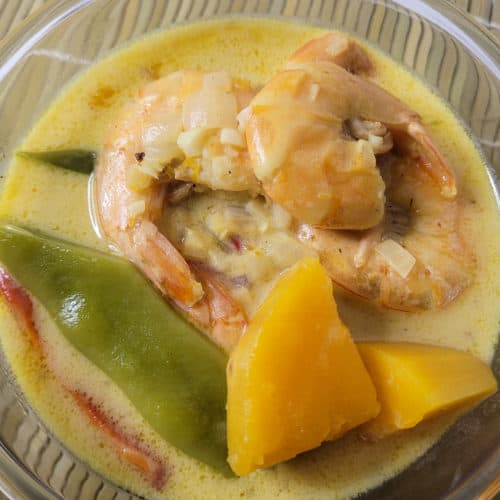
Ginataang Hipon at Kalabasa - Shrimp & Squash in Coconut Sauce
Disclosure
The equipment and ingredients sections contain affiliate links to products I love to use as well as items that I personally believe make this recipe the best version of itself.
Ingredients
- 500 grams (~1 pound) whole shrimp, deveined with shell on optional: head or headless
- 200 grams Kabocha pumpkin, cut in large pieces optional: you can substitute Butternut squash
- 1 can (14 oz) coconut milk
- 1 medium onion, diced
- 4 cloves garlic, minced
- 2 tablespoon ginger, minced
- 100 grams green beans (preferably snake beans) optional
- 1 bell pepper, thickly juliened optional
- 3 tablespoon fish sauce
- ¼ teaspoon turmeric optional; only use when you are not using Kabocha pumpkin
- ⅛ teaspoon crushed black pepper & salt optional; add more or less to your taste
- ½ teaspoon chili flakes optional
Instructions
- Add a little bit of oil to a stock pot and heat. Then add ginger, onions, and garlic and cook until onions are glassy.
- Add coconut milk, water (optional), pumpkin, and beans. Simmer on low for 10-15 minutes
- Add shrimp and fish sauce, then simmer for 5-8 minutes
- Add bell pepper and continue simmering for 5-8 minutes
- Add salt, pepper, chili flakes (optional) and turmeric (optional; use if not using Kabocha) then mix and take off heat




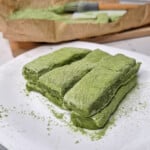

Leave a Reply